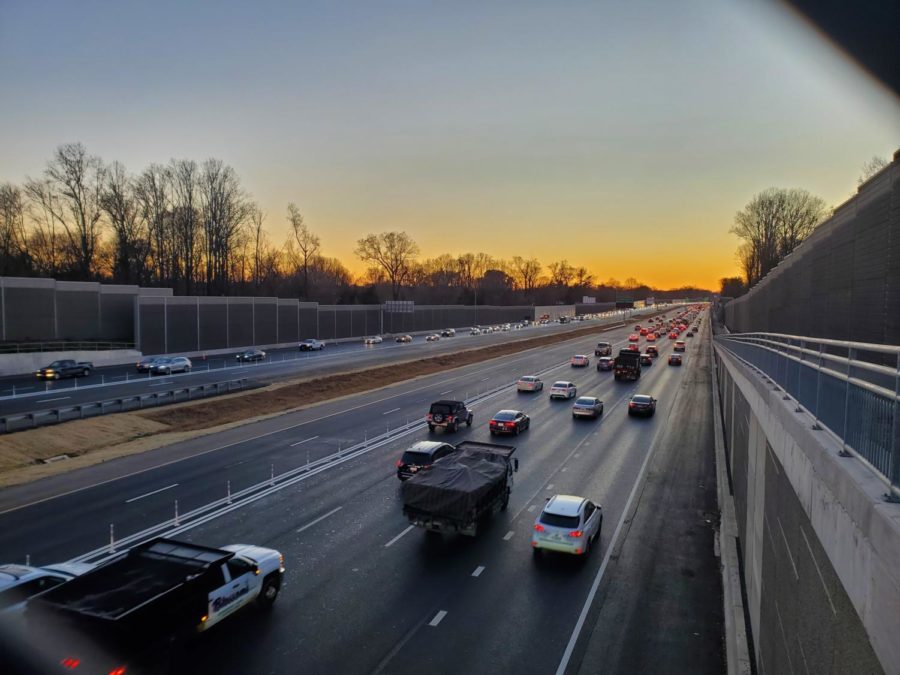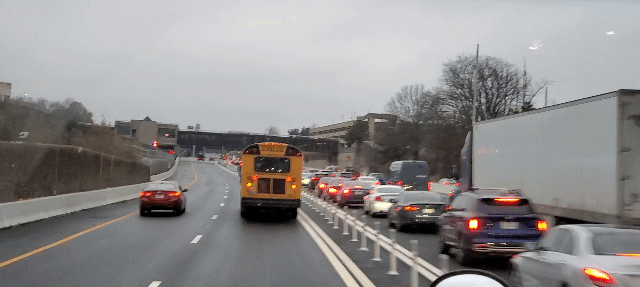What a lane changes
The I-66 Express Lanes at sunset on a November day.
March 10, 2023
Since the I-66 Express Lanes opened last Nov., breezing by standstill traffic has become a daily routine for the approximately 480 Jefferson students who live along the corridor and use a school bus on the lanes to get to school.
High-Occupancy Toll lanes (HOT lanes), also known as “Express Lanes” or pejoratively, “Lexus Lanes” have exploded in popularity across the US in the past 25 years. HOT lanes are generally one or two lanes, usually in the center of existing highways, that drivers can enter only by paying a toll or having multiple people in their car. The price of the toll is adjusted based on traffic to keep these lanes flowing smoothly.
Proponents point out that the lanes dramatically increase a corridor’s capacity by regulating prices to keep the lanes busy, but just below the point of congestion. Free access for high-occupancy vehicles and faster travel times for buses also help expand the use of public transit where they are built, as demonstrated by an HOT project on another section of I-66. At the same time, some have opposed the lanes, arguing that tolled lanes create a two-tiered system that disproportionately hurt low-income individuals, and pointing to continued traffic in the regular lanes.
One voice that’s left out of the conversation: students. School buses are among the vehicles that take the new express lanes, and they allow a faster, smoother, and more reliable commute for many of the 29% of Jefferson students who use I-66 to get to school.
“We probably get to school around 15 minutes earlier, maybe a bit more,” senior Michael Owoyemi, who lives along the I-66 corridor in Prince William County, said. “Getting home is [around] half an hour faster.”
Bus drivers, like Jimmy Atalla, are also reaping the benefits from the new lanes.
“[The Express Lanes are] absolutely lovely,” Atalla said. “Saves a lot of time for us.”
Time saved by the express lanes in turn means both students and bus drivers seize back a part of their day, especially crucial because Jefferson students live far from the school and have long average commute times, as counselor Christina Ketchem explains.
“Commuting can be really difficult for kids, especially those who come from far away in Loudoun or Prince William [counties],” Ketchem said. “ Sometimes [bus rides last] for upwards of two hours each way. It can negate [kids’ ability to engage in] sports, for example, or doing weekend activities.”
While the 10 to 30 minute difference from the express lanes may not seem like much, it adds up. For the 480 students who use the lanes, this means about 17,000 combined hours saved per school year, even after taking into consideration that most students will not be using the lanes for their entire extent. And beyond the time savings and consistency improvements, students say the best part may be the incredibly gratifying feeling of passing Porsches and Teslas, in a school bus.
“It feels so, so good,” Owoyemi said.







